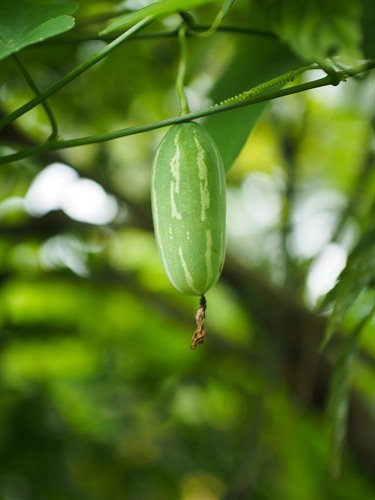
Back
Coccinia grandis (L.) Voigt
| Family Name: | Cucurbitaceae |
| Synonyms: | Coccinia indica |
| Common Name: | Ivy Gourd, Scarlet-fruited Gourd, 红瓜 |
Name
Classifications and Characteristics
| Plant Division | Angiosperms (Flowering Seed Plants) (Dicotyledon) |
|---|---|
| Plant Growth Form | Climber |
| Lifespan (in Singapore) | Perennial |
| Mode of Nutrition | Autotrophic |
| Plant Shape | Irregular |
Biogeography
| Native Distribution | Africa to Malesia |
|---|---|
| Preferred Climate Zone | Tropical, Sub-Tropical / Monsoonal |
Description and Ethnobotany
| Growth Form | A perennial, dioecious vine that can grow up to a length of 20 m. |
|---|---|
| Roots | Plant has tuberous roots and climbs via simple tendrils. |
| Foliage | Leaves are green. Shape can be broadly ovate, subpentagonal to orbicular in shape and may lightly or palmately lobed. |
| Stems | Stems are green and herbaceous when young that turn woody with age. |
| Flowers | Flowers are white and have five petals. Male flowers produced singly or in pairs. Female flowers are produced singly and have a distinctive but small and cylindrical ovary measuring up to 1.5 cm in length. |
| Fruit | Fruits are freshly and elliptical in shape. When young, fruits are green and have white stripes on them. They turn red when mature. |
| Habitat | Plants can be found growing in wastelands and fences in full sun to semi-shade. |
| Cultivation | Prefers to be grown in moist, well-drained soil and humid environment. Provide a trellis for plant to climb on. |
| Etymology | The genus Coccinia means scarlet, which refers to the fruit colour when it ripens. The specific epithet grandis means showy which refers to the attractive colour changes when the fruit ripens from green to scarlet. |
| Ethnobotanical Uses | Edible Plant Parts : Edible Fruits, Edible Leaves, Edible Stems Food (Fruit or Vegetable): Young shoots and leaves are edible and prepared by frying, blanching or boiling. Young fruits of non-bitter varieties are used in soups and curries. They can also be fermented or made into dehydrated chips which can be stored for prolonged periods. Medicinal: Fruits are used in folk medicine and purported to potentially useful for the treatment of diabetes. |
Landscaping Features
| Desirable Plant Features | Ornamental Flowers, Ornamental Fruits |
|---|---|
| Landscape Uses | Container Planting |
Fauna, Pollination and Dispersal
| Fauna Pollination Dispersal Associated Fauna | Bee-Attracting |
|---|
Plant Care and Propagation
| Light Preference | Full Sun |
|---|---|
| Water Preference | Little Water |
| Plant Growth Rate | Fast |
| Rootzone Tolerance | Fertile Loamy Soils, Well-Drained Soils, Moist Soils |
| Maintenance Requirements | Low |
| Propagation Method | Seed, Stem Cutting |
| Propagation Method Remarks | Propagated from seeds or by using 10 cm long, semi-woody stem-cuttings. |
Foliar
| Foliage Retention | Evergreen |
|---|---|
| Mature Foliage Colour(s) | Green |
| Foliar Type | Simple / Unifoliate |
| Foliar Arrangement Along Stem | Alternate |
| Foliar Shape(s) | Non-Palm Foliage (Ovate) |
| Foliar Margin | Entire, Sinuate |
| Typical Foliar Area | Microphyll ( 2.25cm2 - 20.25 cm2 ) |
Non - Foliar and Storage
| Stem Type & Modification | Woody, Herbaceous |
|---|---|
| Root Type | Underground (Fibrous Root) |
| Specialised Storage Organ(s) | Underground (Root Tuber) |
Floral (Angiosperm)
| Flower & Plant Sexuality | Unisexual Flowers , Dioecious |
| Flower Colour(s) | White |
|---|
| Individual Flower Shape | Campaulate / Bell-shaped |
| Flowering Period | Free-Flowering |
| Flowering Habit | Polycarpic |
Fruit, Seed and Spore
| Mature Fruit Colour(s) | Red |
|---|---|
| Fruit Classification | Simple Fruit |
| Fruit Type | Fleshy Fruit , Berry |
Image Repository
Others
| Master ID | 81 |
|---|---|
| Species ID | 1377 |
| Flora Disclaimer | The information in this website has been compiled from reliable sources, such as reference works on medicinal plants. It is not a substitute for medical advice or treatment and NParks does not purport to provide any medical advice. Readers should always consult his/her physician before using or consuming a plant for medicinal purposes. |

.jpg)
.jpg)






